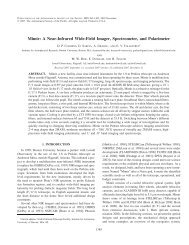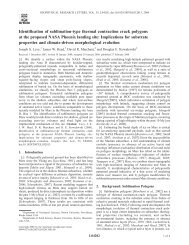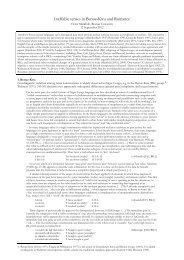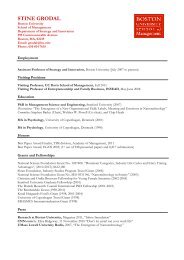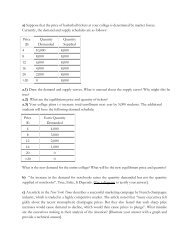Intertemporal Substitution and Recursive Smooth Ambiguity ...
Intertemporal Substitution and Recursive Smooth Ambiguity ...
Intertemporal Substitution and Recursive Smooth Ambiguity ...
Create successful ePaper yourself
Turn your PDF publications into a flip-book with our unique Google optimized e-Paper software.
This relation holds true because i is more risk averse than j in the first stage.Turn to the proof of the converse statement. Fix a set E ⊂ S such that λ = ∫ π(E)dµ P s t(π) ∈s t(0, 1). Suppose (c, δ[l]) ≽ j s(c, λδ[l ′ ] + (1 − λ)δ[l ′′ ]) for l, l ′ , l ′′ ∈ L. Let h t +1 be the one-stepaheadact that gives l ′ if event E happens <strong>and</strong> gives l ′′ , otherwise. Then by definitionwe can show that b(h +1 , µ s t) = λδ[l ′ ] + (1 − λ)δ[l ′′ ]. Using the representation in Theorem3, we can verify that (c, b(h +1 , µ s t)) ∼ j s(c, δ[h t +1 ]) or (c, λδ[l ′ ] + (1 − λ)δ[l ′′ ]) ∼ j s t(c, δ[h +1 ]), which implies (c, δ[l]) ≽ j s(c, δ[h t +1 ]). By comparative ambiguity aversion, wehave (c, δ[l]) ≽ i s(c, δ[h t +1 ]). Since (c, λδ[l ′ ] + (1 − λ)δ[l ′′ ]) ∼ i s(c, δ[h t +1 ]) holds as well, weobtain (c, δ[l]) ≽ i s(c, λδ[l ′ ] + (1 − λ)δ[l ′′ ]). Hence we havet(c, δ[l]) ≽ j s(c, λδ[l ′ ] + (1 − λ)δ[l ′′ ]) =⇒ (c, δ[l]) ≽ i t s (c, t λδ[l′ ] + (1 − λ)δ[l ′′ ]).We can extend this result to all λ ∈ (0, 1) by continuity (Axiom B1) <strong>and</strong> Axiom B4 (FirstStage Independence). We can also extend this result to all finite lotteries over L by repeatedlyapplying the above argument. We finally extend it to all lotteries over L by continuity ofpreferences (Axiom B1).E Appendix: Proofs for Section 5Proof of Proposition 7:Defineφ t (α) = V t (c + αδ) ,for an adapted process (δ t ) . Using equations (24)-(26), we have:φ t (α) = W (c t + αδ t , R t (V t+1 (c + αδ))) .Taking derivatives in the preceding equation yieldsφ ′ t (0) = W 1 (c t , R t (V t+1 )) δ t{+ W 2 (c t , R t (V t+1 )) v ′ ◦ u ( −1 E πz,t [u (V t+1 )] )Ev ′ µt(R t (V t+1 )) u ( ′ u ( −1 E πz,t [u ′ (V t+1 )] ))E [π z,t u ′ (V t+1 ) φ ′ t+1 (0) ]}Define λ t as in (22) <strong>and</strong> E z tas in (23). We obtain:[ ]Eφ ′ zt (0) = λ t δ t + E t+1t φ ′Etz t+1 (0) ,where E t is the conditional expectation operator with respect to the predictive distribution∑z µ t (z) π z (·|s t ) . From this equation <strong>and</strong> the definition in (21), we can derive that ξ z t =E z t λ t .51



